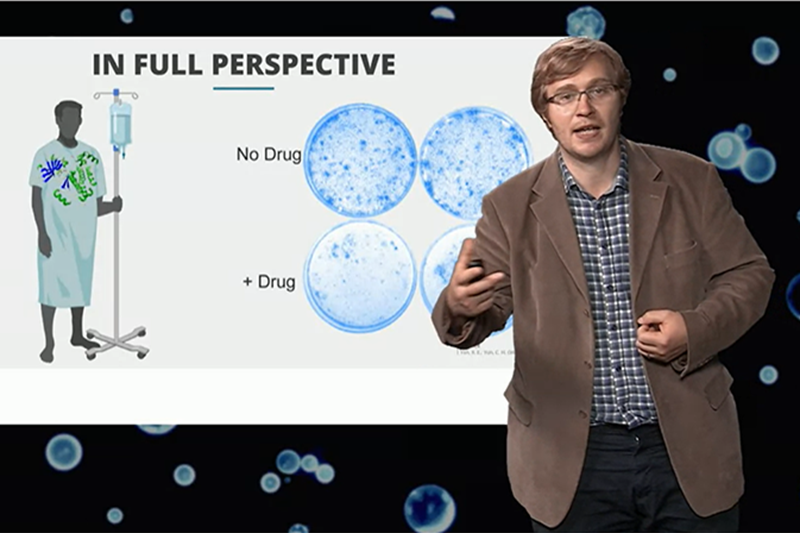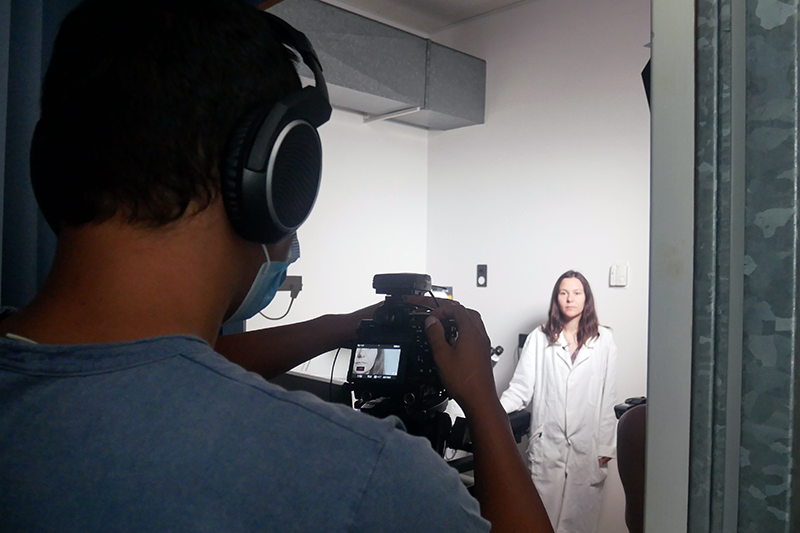On September 30, 2020, we have launched the first MOOC on Chemical Biology on the Coursera platform. The creation of this MOOC was an incredible endeavor led by a passionate team of the NCCR Chemical Biology! We wanted to share with you the backstage of this journey, with the interview of Dr. Marcus Long, Research Associate at the University of Geneva, who has coordinated and directed the process during more than a year and despite the COVID-19 sanitary crisis.
The first MOOC on Chemical Biology is now available on the Coursera platform. Could you briefly describe the course?
The course is divided into 6 modules and requires about 20 hours of work to complete. The line of logic starts from basic science, all the way to applied science. The course covers the three principle themes of chemical biology, which are chemistry, biology, and physics, and blends those together in a logical manner to lead the student through what modern chemical biology concepts are, in terms of how to think at the interface, and apply concepts from different areas to problems that are not solvable by traditional means.
Why did you selected this line of logic?
We chose a line of logic that would enable us to highlight some of the excellent research from the NCCR Chemical Biology labs. We wanted to bring people into our ‘homes’ while teaching them useful things as well. For example, in the MOOC, we see microscopists in action or scientists using high-throughput equipment. Obviously, that is something you cannot do in a normal course. When I was a student, I just sat there and some guy wrote on a board very exciting stuff but I never got to go in the lab and see what was actually happening.
Is this what makes this new MOOC on Chemical Biology so unique?
Indeed, the blending of so many different areas makes it unique. You can see that missing in many enzymology or biochemistry courses where you are taught only about different pathways, while here we expand that in multiple directions talking also about e.g. physics or multiple different techniques. So it’s unique in terms of the multidimensionality and the breadth that we cover.
What is the blend between theoretical versus practical applications?
The theoretical and practical approaches are synergistic in many ways. Understanding theory and applying it means that you need to learn new theoretical aspects and then it cycles up. By the end, you are applying the earlier concepts in multiple layers, theoretically and practically. It’s a generally very feedforward experience, if it’s done right. You understand, for instance, the cell and then you need to understand how a cell grows. Then when you know how cells grow, we can think and apply those concepts to – for example – fish growth. In the course, we have gone through understanding cell biology to thinking more about tissues and organisms.

What type of educational activities are proposed in this MOOC?
In a MOOC, educational possibilities are limited. It is all done through an online interface. So the important thing is to make your videos exciting. MOOC students need to feel involved. If you get the right people and vary the different instructors in the course, so they appeal to different people, students will get hooked.
The other thing is that we have in this MOOC a nice line of logic that people can easily follow. It is important that the students feel that they are progressing in their understanding. And as you go along, you feel that you’re getting for example to learn about screening, screening at a larger scale, larger numbers of cells being screened, with larger number of compounds, etc., and understanding things on a more global perspective.
We also focused on making sure that the problems presented in this MOOC were engaging. We have spent time creating new material. Students will design their own experiments, their own proteins or do very tactile things, which in traditional courses, maybe they couldn’t do.
Overall, this MOOC brings a diverse and divergent experience, which gives the students an exciting and stimulating background. Participants will come out of the course, feeling that they have achieved something.
What is the MOOC’s target group?
Obviously, we are targeting students in science, but also all the spectrum of scientists and science educators. People who have been doing science for a long time will benefit from the course if they’ve been in a particular field, if they want to diversify their portfolio, their way of thinking or get into a new field.
This is also a good course to learn how to communicate with people who don’t speak the same scientific language as you. We have assembled scientists who have worked in many different fields and areas, to help even experienced people feel that they can be more confident talking about something that maybe they were less confident about before.
This MOOC is more adapted for those who have at least a minimum of chemistry background, but if you do not, you can certainly still try. The chemistry that is applied in chemical biology is not necessarily as complicated as people think. There are also people who have never done biology who can do chemical biology. This MOOC should help you broaden your perspective and break down some of your intellectual barriers.
Is this course necessary?
If you cannot communicate to the right people and you cannot be that glue that links different ideas together, you will be more and more isolated, as more and more people want to get involved in interfacial and applied science. So the course will get you ahead of the game or potentially in line with the game.

A few words to describe your team?
Nolwenn Chavan, Science communicator, has been fantastic. She has read everything and pretty much done the whole course. She had a very good eye to how content should be communicated so the majority of people can understand and keep up with it.
One level above was Prof. Robbie Loewith (University of Geneva) who initiated this MOOC and was very good at liaising with everyone. He knew exactly who should be involved.
Phaedra Simitsek, COO of the NCCR Chemical Biology, was very helpful with organizing things and liaising with the MOOC cell at the University of Geneva
The MOOC cell was very useful for filming organizing, as we had a large amount of filming that we had to do both in the labs and at the Radio television Suisse (RTS). RTS organized excellent workshops on how to perform, how to talk, which then Robbie and I could disseminate to the speakers.
There were some really nice videos in the lab that people just did on the fly. That was a fantastic experience. We are very grateful to these junior scientists, which kindly gave of their time.
In terms of speakers, we assembled, Prof. Howard Riezman, the NCCR director, and the NCCR members: Prof. Aurélien Roux and Robbie Loewith. In the MOOC, they do a very nice discussion of their work on member tension. We also have Prof. Nicolas Winssinger, Prof. Anne-Claude Gavin and Prof. Yimon Aye. In her EPFL lab, Yimon Aye presents a video on developing ideas and concepts, focusing on how you can change field and apply your ideals trends in an interdisciplinary fashion and achieve something from it.
What was your most challenging part during the preparation?
The most challenging part is probably creating the content! We have six modules, each has about seven videos and 20 to 30 slides per video. All the content and illustrations were created de novo, so as to achieve not just a consistent logic, but a consistent look.
What do you see as the biggest challenges for the future?
We have made something that’s quite robust for five years.
Our approach was to bring something new to the cause rather than going over the same old ground that has already been covered. Some of the papers and the work are from publications that are reasonably old, but they were chosen precisely because they bring in a new concept and concepts are not going to get a lot older in the next five years.
The way we pitched the content, the ideas, concepts and the core values we present create a core background, that ultimately people really tend to need to know but that they actually often tend to get wrong.
If you teach a student a complicated concept, they remember it and latch onto it while they usually forget the real basic fundamental idea that this is your golden rule. It is really those kinds of fundamental things that we focus on in the MOOC, but in an applicable and trans-dimensional way that is useful.
What are your success criteria in a year’s time?
When we pitched the MOOC project to the NCCR Chemical Biology Management team, we talked about how many of us remember the textbooks that we enjoyed. If people are saying, I am applying this technique because I learned it in the correct way in this MOOC, I think we’ve done a very good job.
If we can show that the number of people that join the MOOC, and/ or complete the course, is significantly higher than the average attending let’s say MOOC in sciences , then I think that it will safely imply that the MOOC is very good and we’ll brand our endeavor a success!
Learning with the MOOC should be fun. We have tried to make the videos fun and exciting to generate a learning experience that is fun and exciting. I hope that they do stimulate people to try something new. Even if it’s not chemistry, biology, or physics, but something at the interface, helping the attendee to break down knowledge barriers and gain some confidence to use and apply his/her knowledge to a different area, it is something that’s good for everybody.

Leave a comment
The editors reserve the right not to publish comments or to abridge them.